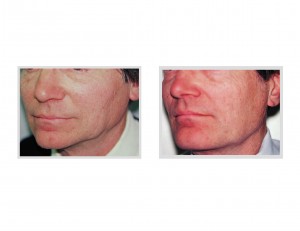The most recognized signs of facial aging is sagging and loose skin. Therefore, the use of facelifting techniques and other soft tissue suspension procedures have been the foundation of any facial rejuvenation treatment program. But recent published and presented research in plastic surgery in the past few years has shown that the underlying bone structures over which the soft tissue sags is a contributing cause as well. Bone resorption along facial bony prominences occurs as well and this contributes to the falling tissue process. As the soft tissues slide off of the face with aging, that process is accentuated by loss of bone structure.
Bone loss with aging has been shown to occur amongst most facial bones. Many studies support these facial findings including changes along the jaw line. Jaw resorption is well known to occur with tooth loss (edentulism) and this is the result of loss of alveolus or the top part of the jaw bones. Recent work has shown, however, that the basal part of the lower jaw changes as well. This area of the jawbone was previously thought to be unaffected with aging.
From a recently presented study from the University of Rochester, new insights have been provided by studying facial CT scans. Researchers used a computer program to measure the length, width, and angle of the lower jaw bone and compared the results for different age groups. CT scans allow for more accurate tmeasurements than traditional jaw x-rays. Their study shows that he angle of the jaw increases markedly with age, which results in a loss of definition of the lower border of the face. Jaw length and a decline in jaw height also decreases significantly in older age groups.
Since the jaw is the principal support for the lower face, its shape and size affects the overlying soft tissues. As the size of the jaw decreases with age, the soft tissues of the lower face and neck also loses support. This loss of bony volume may contribute to sagging facial skin, decreased chin projection, and loss of jawline definition. As jaw volume decreases, soft tissue of the lower face has less support, resulting in a softer, oval appearance to the lower face and sagging skin, which also affects the aging appearance of the neck.


Dr. Barry Eppley
Indianapolis, Indiana


